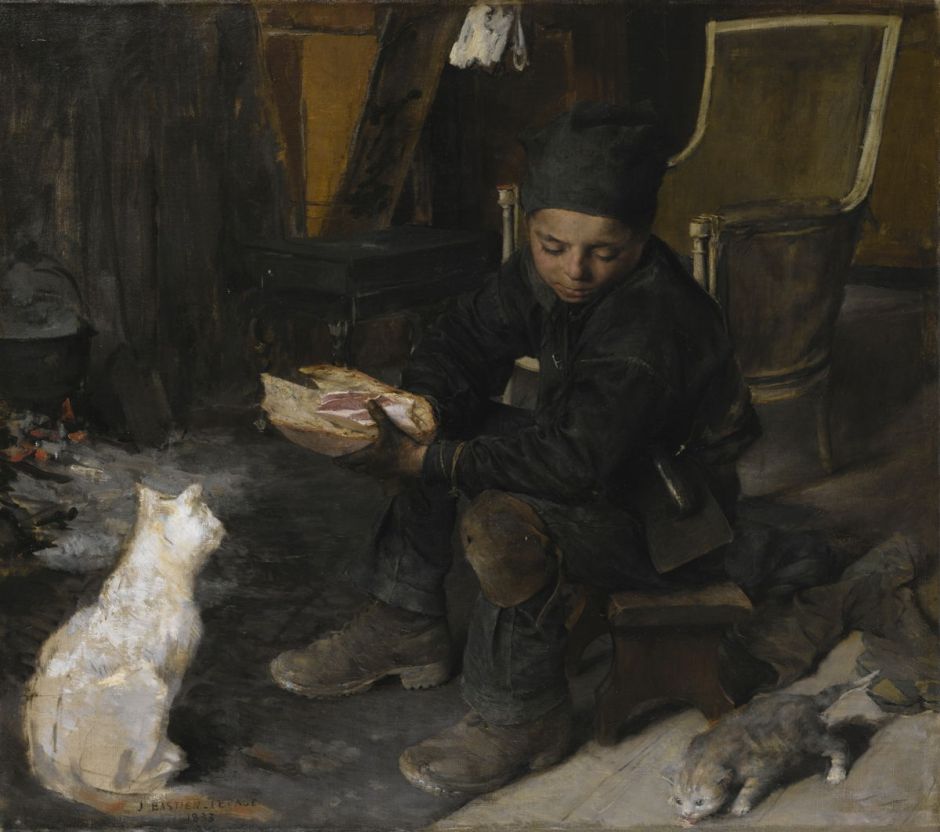From the middle of the nineteenth century, depiction of clothing and fabrics in paintings divides into three:
- social realism and Naturalism, where the reality of the clothes worn by the poor became dominant;
- academic, where little has changed for a century or more;
- modern, including Impressionism and other modern styles.
In this article, I show a selection of paintings from the first category.
Prior to that century, few painters had gone to the trouble of depicting clothing as worn by the majority of the population, the hand-me-downs and ragged tatters of peasants and labourers.

Bartolomé Esteban Murillo is one of the earliest artists to have paid particular attention to vagrants and the homeless. The Young Beggar, painted by him in about 1645, shows a young boy apparently squatting in a tiny bare nook in a building. By his filthy feet is a bag full of rotting fruit, and some sort of worms, which apparently form his diet. His clothes are made of poor cloth, dull browns and greys, and have worn bare, torn and frayed.
Although other artists like Francisco Goya provide occasional glimpses of clothes of the lower classes, it wasn’t until the middle of the nineteenth century and social realism that they became a central feature.

Jean-François Millet hints subtly at the state of peasant clothing in The Gleaners (1857). Although this is about the rural poor, who made ends meet by salvaging scraps after the harvest had been cut, he doesn’t attempt to show fine detail in clothing.

Jules Breton’s Calling in the Gleaners (also known as The Recall of the Gleaners, Artois) (1859), from just a couple of years later, is quite different. Although the women’s clothes appear quite clean at the end of a hard day’s gleaning, Breton goes out of his way to show rips and frayed hems.

Twenty years later, as social realism was turning into Naturalism, Christian Krohg started a career-long series of paintings of working seamen, in Port Side! (1879). This seaman’s oilskins have been patched repeatedly, and have deeply ingrained grime. This was one of two of his paintings exhibited at the Salon in Paris in 1882, and although it didn’t attract a great deal of critical attention, the reviews it received were positive.
The Naturalist Jean-Eugène Buland, now almost forgotten, painted the greatest study on the reality of clothing at this time.

In Alms of a Beggar (1880), a young woman dressed immaculately in white is sat outside a church seeking charity. Approaching her, a coin in his right hand, is a man who can only be a beggar himself. His clothes are patched on patches, faded and filthy, and he wears battered old wooden shoes. Yet he is about to give the young woman what is probably his last coin.
There are many other paintings from the early 1880s which go out of their way to show the rags many wore as clothes.

Léon Lhermitte’s huge painting of The Harvesters’ Pay (1882) is an unusual take on the harvest, and a fine study of the working dress of country labourers. Four of the harvesters, bearing their heavy-duty scythes, await payment by the farmer’s factor, the only person whose clothing isn’t on its last legs.
In the centre of the painting, one of the workers is counting out his pay in front of his wife, who is feeding a young infant at her breast. To their left, another worker just sits and stares blankly into the distance, dead-beat tired and wondering whether his pittance was worth all that effort. Life was hard, and their clothing looks as if its life has been just as hard.

Jules Bastien-Lepage, whose paintings of the rural poor succeeded at the Salon where others had failed in the past, painted this cheeky ploughboy in 1882. Pas Mèche (Nothing Doing) shows him equipped with his whip and horn, on his way out to work in the fields. His face is grubby, his clothing frayed, patched, and dirty, and his boots caked in mud and laceless.

Ernst Josephson’s Spanish Blacksmiths (1882) is a fine example of a Naturalist portrait in which its apparent objectivity is enhanced by the white wall behind them. Josephson has painted every rip, tear and fray in the remains of the white shirt worn by the man in the middle, and his muscular forearms are almost hyper-real.

The year before Bastien-Lepage died suddenly, The Little Chimneysweep (Damvillers) (1883) shows the dirtiest of his waifs, his left hand and clothes black with soot from his work.

Most of Fernand Pelez’s paintings of the poor are deeply unsettling, often frankly depressing. His Homeless from 1883 shows a worn and weary mother and her five children living on the street. She stares from sunken eyes straight at the viewer, as her children huddle in filthy blankets and sacking around her. Only the mother and her oldest daughter (who is presumably already at work) wear any shoes.
Although Naturalism continued after Bastien-Lepage’s death in 1884, paintings showing the reality of the clothing of the masses soon fell from favour.
Reference
Anne Hollander (2002), Fabric of Vision, Dress and Drapery in Painting, National Gallery and Yale UP. ISBN 1 85709 907 9.

